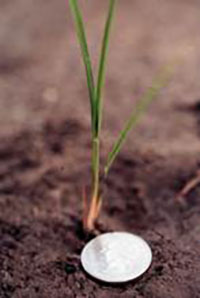
Managing soil pH is important in a soybean-rice rotation. Low pH can cause aluminum and manganese toxicity in plants. Soybean needs a pH of about 6.0 to have good root nodulation and nitrogen fixation. It is best to apply lime during the year that soybean is grown. Liming before rice can cause a period of high pH, leading to a zinc deficiency in the rice that hinders its development of the air tubes that transport oxygen from its stems to its roots.
Most rice varieties require 90 to 150 lbs. total nitrogen (N) per acre. About 60%–100% of the nitrogen should be applied before flooding the field. This is usually done at the first tiller growth stage (Figure 1).
Nitrogen applied before flooding should be made on dry soil, followed by irrigation designed to establish a permanent flood. Urea is the preferred N source. Scout fields during the growing season with sensors or tissue testing to determine whether the rice needs additional N. Midseason N is typically applied at green ring or early internode elongation growth stages (Figure 2).

Phosphorus (P) and potassium (K) are essential for rice growth and yield. While P is generally tightly bound to the soil, flooding increases its availability to the plant. Soil test recommendations for P are at minimum 30 lbs. P2O5 per acre. Potassium moves through the soil profile when cation exchange capacity (CEC) is low. Soil test recommendations for K are dependent on this soil texture component, represented by this equation:
120 + (5 x CEC) = lb K2O required
See Page 8 in Crop Nutrient Deficiencies and Toxicities for photos illustrating nutrient deficiencies in rice. Nitrogen deficiency causes pale green plants. Phosphorus deficiency causes with plants with a reduced size and dark green leaves. Low potassium causes leaves with brown around leaf edges and reduced stalk strength. Sulfur (S) deficiency can be difficult to differentiate from nitrogen. Plants with low S often have yellow leaves at the top.